NCMP trends in children’s BMI between 2006 to 2007 and 2019 to 2020
Updated 21 April 2021
Applies to England
Summary of main findings: academic years 2006 to 2007 and 2019 to 2020
The main findings from this year’s child weight trends report are:
- obesity and excess weight prevalence showed a downward trend in reception-aged boys, which is driven by a decrease in prevalence for all pupils apart from those in the most deprived areas, which showed no change
- reception girls and year 6 boys and girls had an upward trend in the prevalence of obesity, excess weight and severe obesity, which was driven by increases for pupils from the more deprived areas, offsetting any decreases seen for pupils from the least deprived areas
- for reception boys, the White British ethnic group was the only ethnic group that showed an upward trend for severe obesity and for reception girls, the White British ethnic group was the only ethnic group that showed an upward trend for obesity, excess weight and severe obesity
- a trend of widening of inequalities was seen when examining the slope index of inequality (SII) for obesity; the obesity inequalities gap was greater in year 6 than in reception and was widening at a faster rate
A summary of obesity, excess weight and severe obesity trends for boys and girls in reception and year 6 are displayed in the table image below.

Table 1: Summary of trends in weight status by age and sex.
Introduction
This report presents trends in children’s body mass index (BMI) from academic year 2006 to 2007 to year 2019 to 2020 using National Child Measurement Programme (NCMP) data. The NCMP is an annual programme that measures the height and weight of over 1 million children per year in reception (aged 4 to 5 years) and year 6 (aged 10 to 11 years) in mainstream state-funded schools in England. Although the NCMP only covers certain age groups, it normally includes most children in those year groups (usually around 95% of eligible children). Low participation levels for year 6 between 2006 to 2007 and 2008 to 2009 led to underestimation of obesity prevalence and these years are not included in the analysis for year 6 when looking at prevalence trends over time.
School closures in March 2020 due to the COVID-19 pandemic meant that in 2019 to 2020 the number of children measured was around 75% of previous years. Analysis by NHS Digital and Public Health England (PHE) shows that national level data is reliable and comparable to previous years and is included in the trend analysis although some caution should be exercised as less children were measured than usual. Further information is available in the NHS Digital 2019 to 2020 annual report.
The report depicts the trends in child BMI from the NCMP in clear, easy to understand charts and graphics. They display overall trends in obesity, excess weight, and severe obesity prevalence over time. The slope index of inequality (SII) for obesity provides an indication of whether existing health inequalities are widening or narrowing.
Throughout the report, where an upward or downward trend is mentioned, it is statistically significant.
The report will be a useful tool for practitioners and policy makers working on child weight and obesity at local, regional and national level.
The report is the latest in a series of analyses examining trends in child weight status overtime, and supersedes previous reports.
Trends in prevalence by weight category, age and sex
Figure 1 shows the prevalence of obesity, excess weight and severe obesity by school year and sex.
There were downward trends in:
- obesity and excess weight in reception boys
There were upward trends in:
- obesity, severe obesity and excess weight in reception girls and year 6 boys and girls
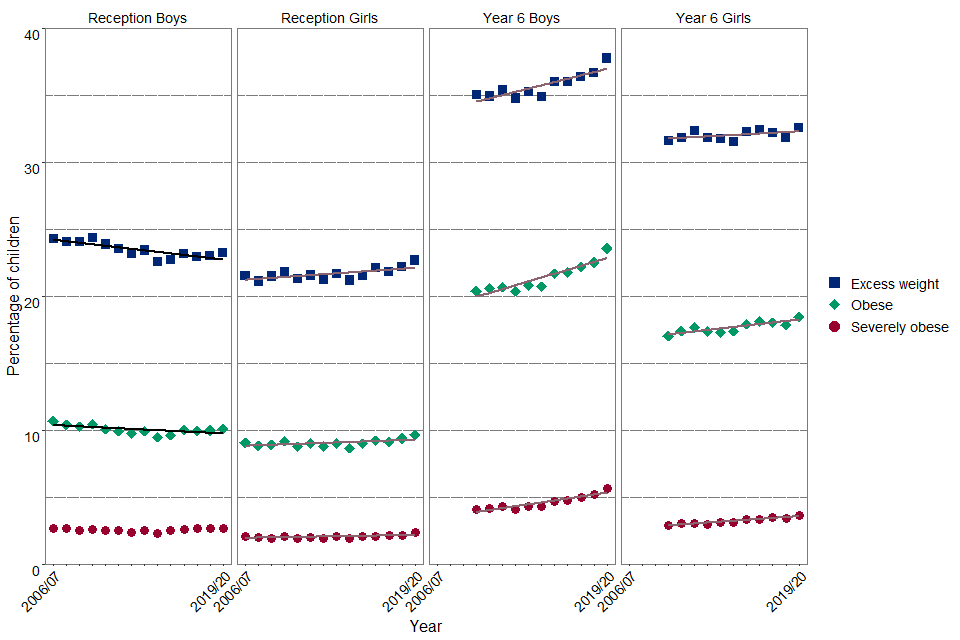
Figure 1: Prevalence of obesity, severe obesity, and excess weight by school year and sex. Significant upward linear trends are indicated with a red line and downward linear trends are indicated with a black line.
Trends in prevalence by weight category, age, sex and deprivation
There is a strong correlation between weight status and deprivation, with children living in the more deprived areas experiencing a higher prevalence of obesity. Data is presented using the Index of Multiple Deprivation (IMD), a measure of relative deprivation for small areas. The small areas are divided according to their deprivation rank into 5 equal groups (quintiles), ranging from the most deprived (quintile 1) to the least deprived (quintile 5).
Inequalities were widening in obesity, excess weight, and severe obesity across all age and sex groups with either the largest increases seen in the most deprived areas or largest decreases seen in the least deprived areas.
The pattern of change in prevalence over time varied between age and sex. For example, the trend in severe obesity in the least deprived area (quintile 5) was downward in reception boys, upward in year 6 boys and had no upward or downward trend in girls in reception or year 6.
Figures 2a to 2d show prevalence by weight category and deprivation quintile for reception boys (Figure 2a), reception girls (Figure 2b), year 6 boys (Figure 2c) and year 6 girls (Figure 2d).
Prevalence by weight category and deprivation quintile for reception boys
In reception boys:
- prevalence of excess weight has decreased in all but the most deprived quintile
- prevalence of obesity has decreased in quintiles 3 to 5
- those living in the most deprived quintile had an upward trend in severe obesity prevalence while those in the least deprived quintile had a downward trend

Figure 2a: Prevalence of obesity, severe obesity and excess weight in reception boys by deprivation quintile. Significant upward linear trends are indicated with a red line and downward linear trends are indicated with a black line.
Prevalence by weight category and deprivation quintile for reception girls
In reception girls:
- the more deprived quintiles (quintiles 1 and 2) had an upward trend in obesity, excess weight, and severe obesity
- in the least deprived quintile, there were downward trends in obesity and excess weight

Figure 2b: Prevalence of obesity, severe obesity and excess weight in reception girls by deprivation quintile. Significant upward linear trends are indicated with a red line and downward linear trends are indicated with a black line.
Prevalence by weight category and deprivation quintile for year 6 boys
In year 6 boys:
- prevalence of severe obesity was increasing across all quintiles
- prevalence of obesity was increasing across all but the least deprived quintile, and prevalence of excess weight was increasing across quintiles 1 to 3 with the most deprived quintile (1) showing the steepest increases
- the least deprived quintile (5) had a downward trend in excess weight
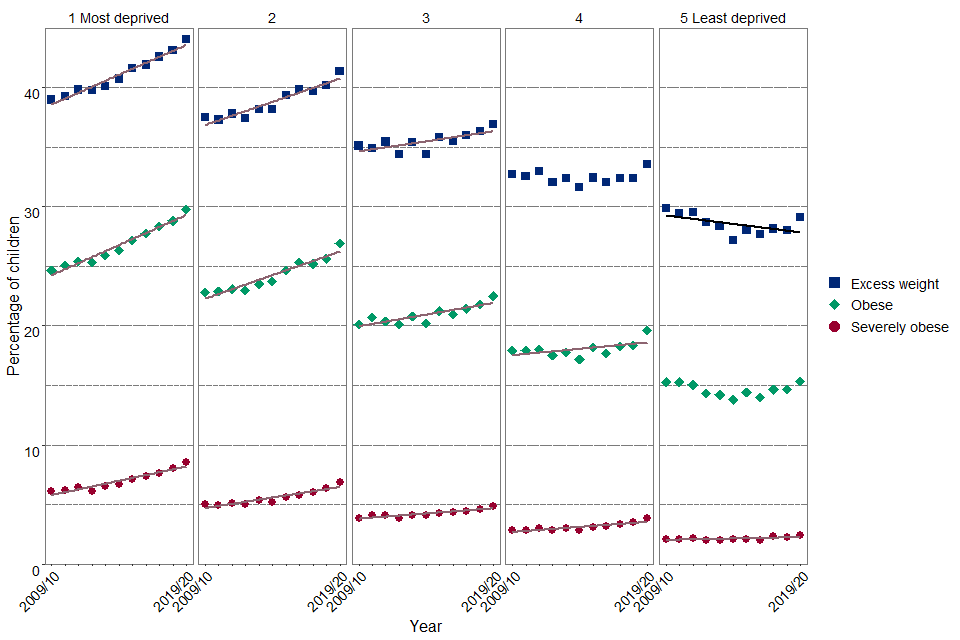
Figure 2c: Prevalence of obesity, severe obesity and excess weight in year 6 boys by deprivation quintile. Significant upward linear trends are indicated with a red line and downward linear trends are indicated with a black line.
Prevalence by weight category and deprivation quintile for year 6 girls
In year 6 girls:
- the 2 most deprived quintiles had an upward trend in obesity, excess weight, and severe obesity while quintile 3 had an upward trend in obesity and severe obesity
- there was a downward trend in the prevalence of obesity and excess weight in the least deprived quintile, and prevalence of excess weight in quintile 4

Figure 2d: Prevalence of obesity, severe obesity and excess weight in year 6 girls by deprivation quintile. Significant upward linear trends are indicated with a red line and downward linear trends are indicated with a black line.
Trends in SII for obesity
The SII for obesity presented in this report measures how obesity prevalence varies by levels of deprivation in communities of the population and summarises the level of inequality. Child obesity prevalence is calculated for each deprivation group (deciles representing approximately 10% of the population), then the SII is calculated based on these figures.
The SII takes account of health inequalities across the whole range of deprivation within England and summarises this in a single number. The higher the value of the SII, the greater the inequality in obesity prevalence. Increasing SII over time indicates widening inequality.
Figure 3 shows the trend in SII for boys and girls in reception and year 6. The SII was greater in year 6 boys and girls than in reception boys and girls. This indicates there was greater inequality in year 6 than in reception. The SII has increased at a faster rate in year 6 than in reception, illustrated by the steeper slope of the trend lines for year 6.
Data between 2006 to 2007 and 2008 to 2009 for year 6 is included in this analysis as the SII looks at the difference in prevalence between deprivation deciles in the same year, rather than changes in prevalence levels across years. The differences between deciles in the same year will be unaffected by the low participation rate assuming that each decile is affected in the same way.
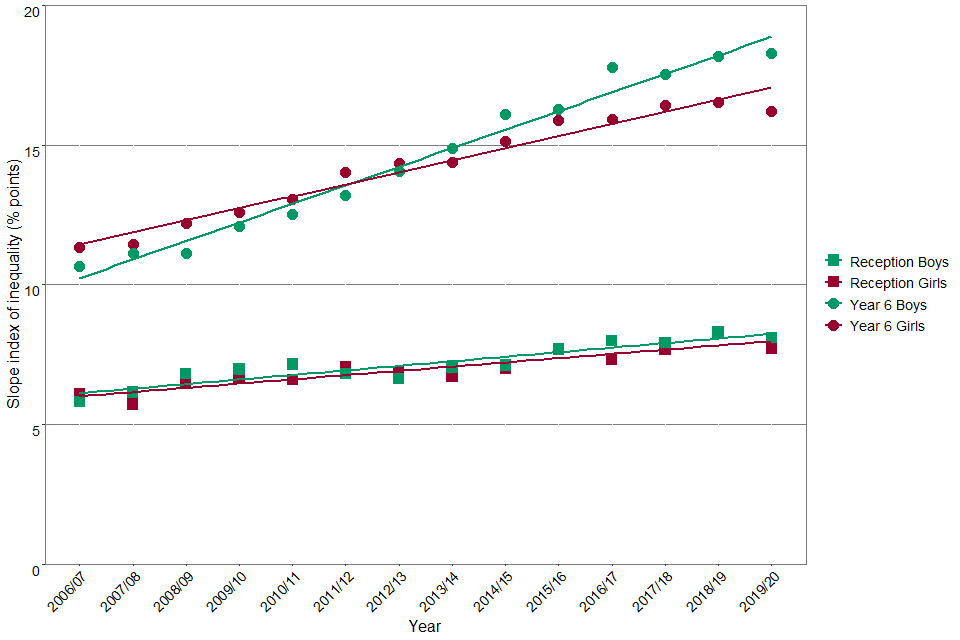
Figure 3: Trend in SII for obesity, by school year and sex. Significant upward linear trends are indicated with a line.
Trends in prevalence by weight category, age, sex and ethnicity
There are known inequalities between weight status and ethnicity.
Prevalence by weight category and ethnicity for reception boys
Figure 4a shows prevalence by weight category for boys in reception by recorded ethnic group.
In reception boys:
- there was a downward trend for excess weight for White British boys, but an upward trend for severe obesity
- Indian, Bangladeshi, Black African and Pakistani boys also had downward trends for excess weight and obesity and Black Caribbean boys had a downward trend for excess weight
- Indian boys showed a downward trend for severe obesity

Figure 4a: Prevalence of obesity, severe obesity and excess weight in reception boys by ethnicity. Significant upward linear trends are indicated with a red line and downward linear trends are indicated with a black line.
Prevalence by weight category and ethnicity for reception girls
Figure 4b shows prevalence by weight category for girls in reception by recorded ethnic group.
In reception girls:
- White British girls had upward trends in prevalence of obesity, excess weight, and severe obesity, whereas in Indian girls there were downward trends in obesity and excess weight
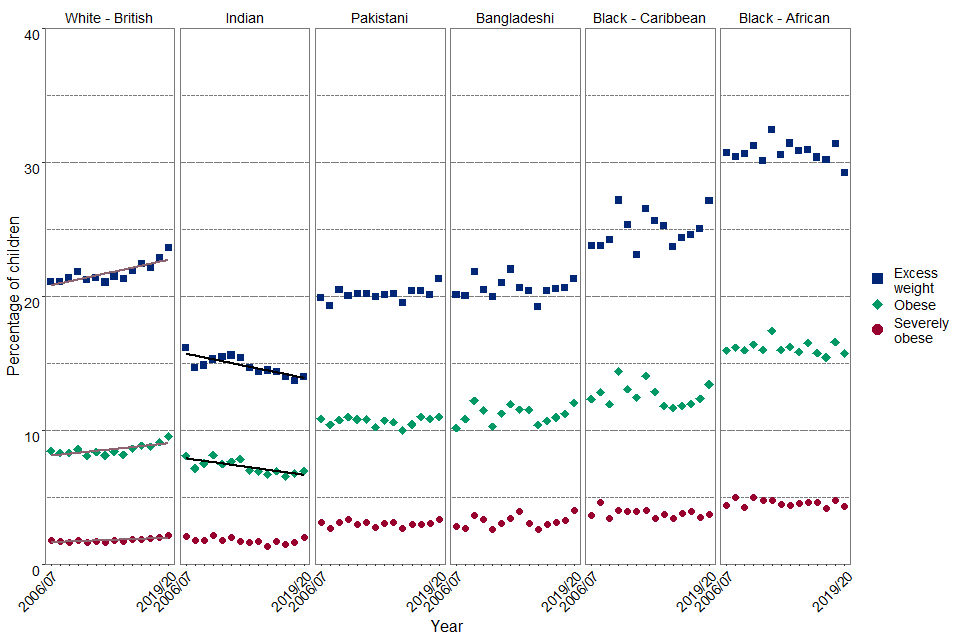
Figure 4b: Prevalence of obesity, severe obesity and excess weight in reception girls by ethnicity. Significant upward linear trends are indicated with a red line and downward linear trends are indicated with a black line.
Prevalence by weight category and ethnicity for year 6 boys
Figure 4c shows prevalence by weight category for boys in year 6 by recorded ethnic group.
In year 6 boys:
- there was an upward trend for obesity in boys in all groups
- all groups except Black Caribbean boys had an upward trend for excess weight
- all groups except Indian boys had an upward trend for severe obesity
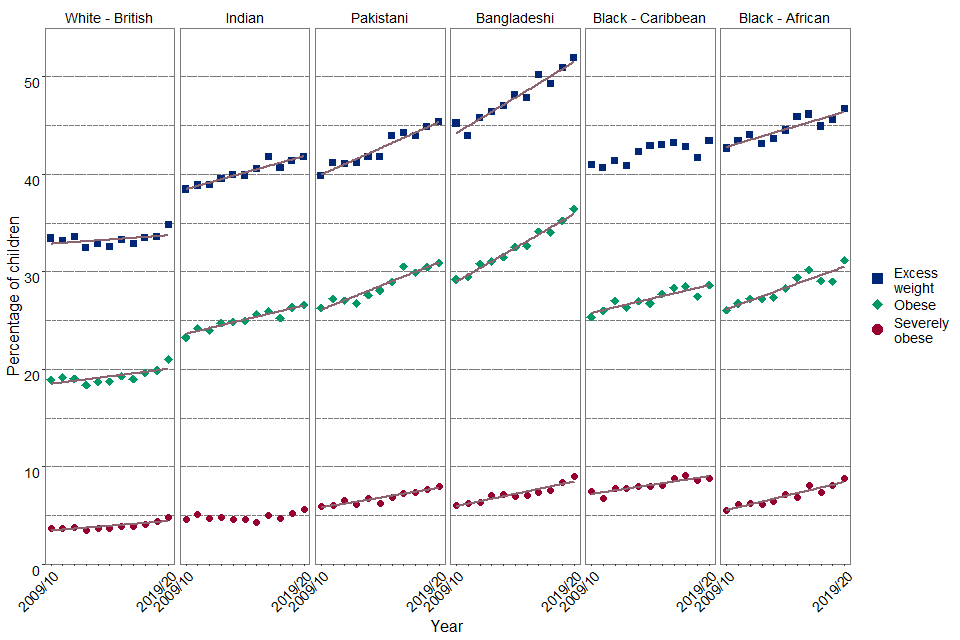
Figure 4c: Prevalence of obesity, severe obesity and excess weight in year 6 boys by ethnicity. Significant upward linear trends are indicated with a red line and downward linear trends are indicated with a black line.
Prevalence by weight category and ethnicity for year 6 girls
Figure 4d shows prevalence by weight category for girls in year 6 by recorded ethnic group.
In year 6 girls:
- there was a downward trend for excess weight in White British girls, but an upward trend for obesity and severe obesity
- Pakistani, Black Caribbean and Black African girls also had an upward trend for severe obesity
- Pakistani, Bangladeshi and Black African girls showed upward trends for excess weight and obesity
- Black Caribbean girls also had an upward trend in obesity

Figure 4d: Prevalence of obesity, severe obesity and excess weight in year 6 girls by ethnicity. Significant upward linear trends are indicated with a red line and downward linear trends are indicated with a black line.
Methodology and further information
Methods
Logistic regression models were used to assess the significance of the trends, using a Bonferroni correction for multiple hypothesis testing. A least squares trend line is depicted on the charts for illustrative purposes. For SII analysis, linear regression models were used to assess the significance of the trend. No Bonferroni correction was applied to SII analysis. R software was used to conduct the analyses and produce all the charts in this report.
Trends in underweight and overweight are not examined in this report, to improve the readability of the charts. Prevalence of underweight, in children measured in the NCMP, is lower than that seen in the British 1990 reference population and is therefore not currently a public health concern. Trends in overweight prevalence need to be examined in the context of changes in prevalence of healthy weight and obesity. For example, increases in overweight prevalence will be a positive change if obesity prevalence is decreasing, but a negative change if obesity prevalence is not changing or increasing.
The trends in weight category prevalence by ethnic group have been restricted to groups with a sample size large enough to achieve meaningful results, therefore the Chinese ethnic group is not shown.
BMI classification definitions for population monitoring
Assessing the BMI of children is more complicated than for adults because a child’s BMI changes as they mature. Growth patterns differ between boys and girls, so both the age and sex of a child needs to be considered when estimating whether BMI is too high or too low. In England the British 1990 growth reference (UK90)[footnote 1] for BMI is recommended for use to determine weight status according to a child’s age and sex. Each child’s BMI is calculated and compared with the BMI distribution for children of their age and sex from the UK90 growth reference. For population monitoring purposes BMI is classified according to the following table using the UK90.
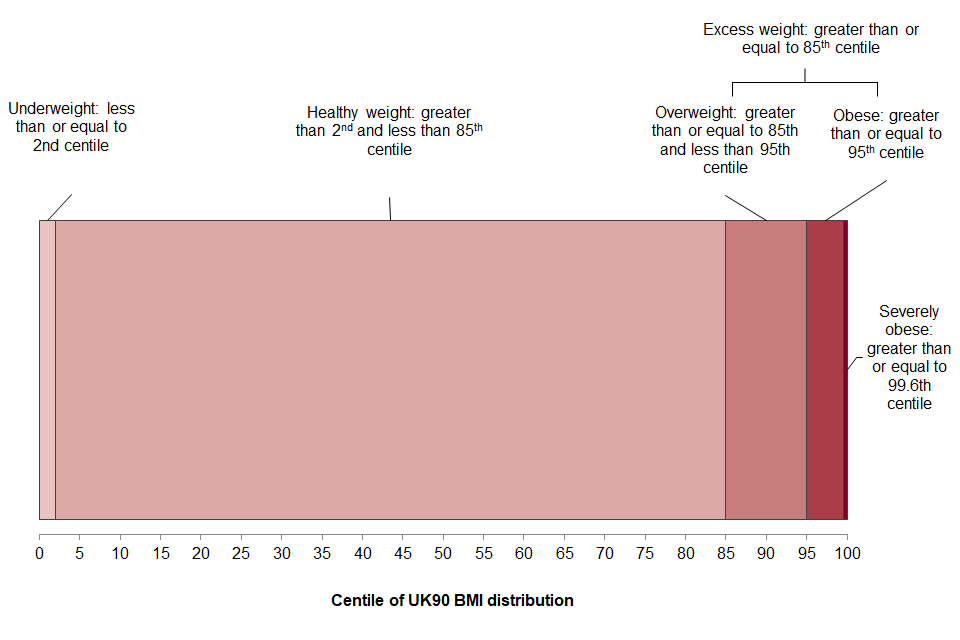
Figure 5: BMI classifications for population monitoring purposes.
Centile of UK90 BMI distribution:
- underweight: less than or equal to second centile
- healthy weight: greater than second and less than 85th centile
- overweight: greater than or equal to 85th and less than 95th centile
- excess weight: greater than or equal to 85th centile
- obese: greater than or equal to 95th centile
- severely obese: greater than or equal to 99.6th centile
A list of PHE data and analysis tools on the topic of obesity can be found on GOV.UK.
Further reports on obesity are available on the PHE Obesity Intelligence Knowledge Hub public library.
Responsible statisticians, product lead: Catherine Bray, Caroline Hancock
For queries relating to this document, please contact: ncmp@phe.gov.uk
-
Cole TJ, Freeman JV, Preece MA. Body Mass Index reference curves for the UK, 1990. Archives of Disease in Childhood 1995 73:25-29 ↩
